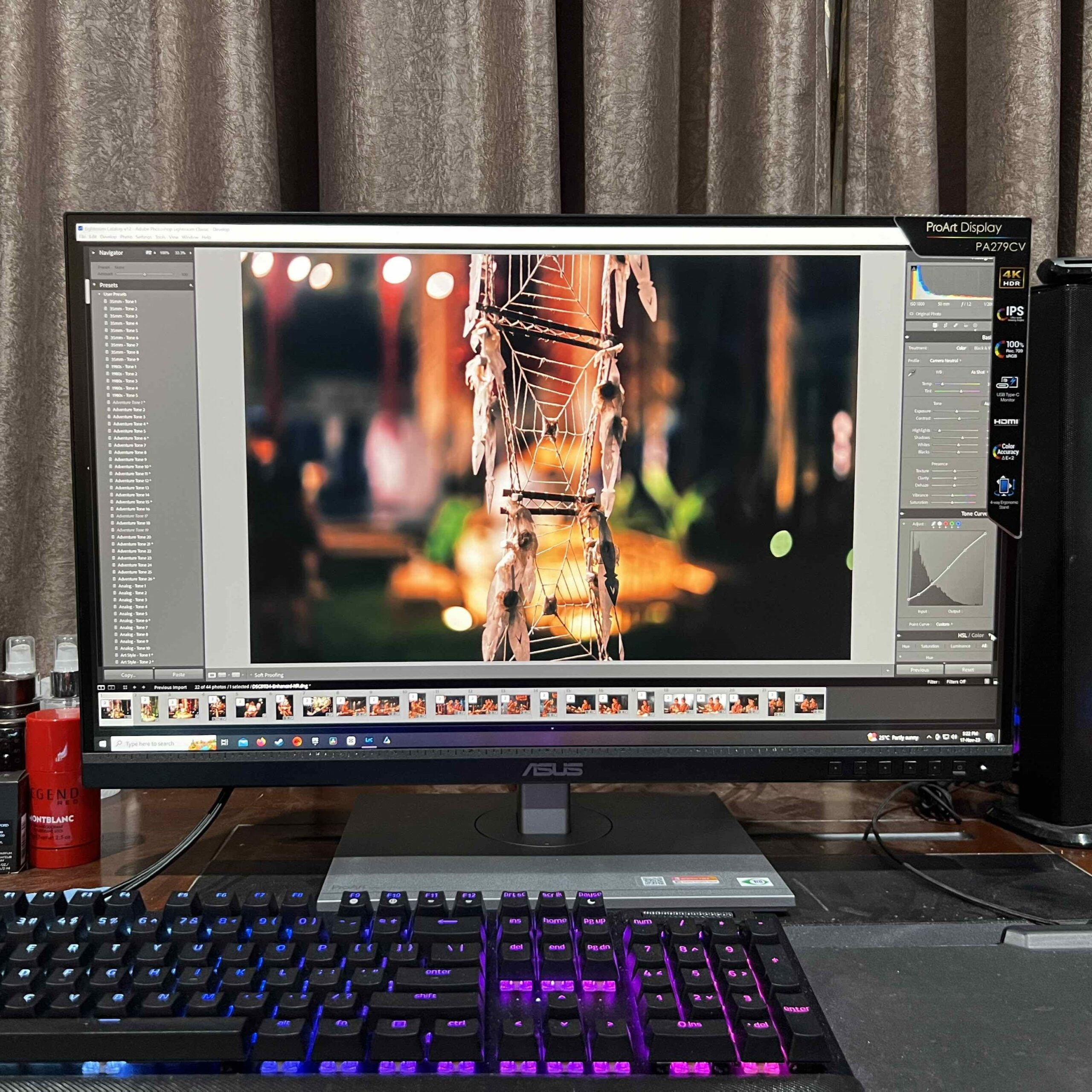Asus ProArt Display OLED PA32DC Review

PROS
- Superior color gamut coverage
- Offers multiple HDR modes
- Included colorimeter works well
- Extra stand and monitor hood included
- Handle for mobility
CONS
- Refresh rate tops out at 60Hz
- High Delta E in testing
- Expensive
ASUS PROART DISPLAY OLED PA32DC SPECS
| Panel Size (Corner-to-Corner) |
31.5 inches |
| Native Resolution |
3840 by 2160 |
| Aspect Ratio |
16:9 |
Asus has consistently delivered exceptional ProArt monitors throughout the years, such as the ProArt PA34VC Professional Curved Monitor. However, the company has truly raised the bar with its latest model, the ProArt Display OLED PA32DC. This monitor stands out as one of the most impressive OLED displays we have encountered, specifically designed to cater to the requirements of video editors, designers, and photographers. It boasts an awe-inspiring contrast ratio, supports various HDR formats, and notably, it is the first OLED monitor we have come across that offers automatic calibration. Undoubtedly, this monitor comes with a substantial price tag. Nevertheless, if you are seeking the ultimate content-creation and photo-editing monitor that money can buy, there are few competitors in the same league as the PA32DC OLED. Furthermore, these competitors often feature fruit logos and charge exorbitant prices for a stand.
An Advanced Professional Monitor.
The Asus PA32DC emanates the ambiance of a top-notch monitor, with its high-quality screen and striking appearance. The sleek 32-inch display, in an all-black design, is elevated by a simple stand featuring a square base and slim bezels surrounding the frame. Conveniently located at the bottom right corner are a series of buttons for swift settings adjustment, along with an OSD control stick. On the right side of the back panel, there is a port hub that provides easy access to three HDMI 2.0 ports, a headphone jack, and a DisplayPort input. Additionally, the left side is equipped with a USB-C jack and four USB-A ports. Notably, a metal handle is situated on the back, enabling you to transport the monitor like a suitcase, albeit a rather expensive one.

The dimensions of the monitor are 18.3 by 28.9 by 2.4 inches (HWD), making it slightly heavier compared to other creative monitors like the MSI Summit MS321UP. It is equipped with back holes spaced 100mm apart in a square pattern, allowing for VESA bracket support (bracket not included) for arm or wall mounting. However, the monitor’s main stand is already quite versatile. It offers a generous height adjustment of approximately 5 inches, a 90-degree pivot from landscape to portrait mode and vice versa, and a swivel range of up to 30 degrees to the left or right. Additionally, you have the option to tilt the top of the monitor towards you by 5 degrees or away by up to 23 degree
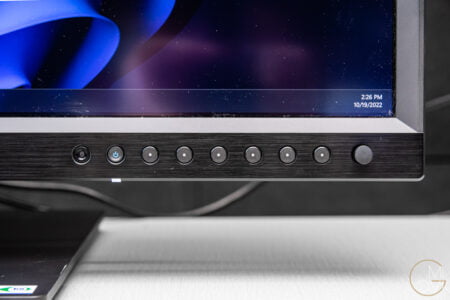
The monitor is equipped with two different stand choices. One option is a traditional-style stand with a spacious base, while the other option consists of two feet that position the monitor at its lowest height above the desk, creating a TV-like appearance. Additionally, the monitor is accompanied by a hood, which is a crucial accessory for professionals as it minimizes glare and distractions, and even impacts the perceived accuracy of colors.

The monitor’s standout professional feature is the built-in, motorized flip colorimeter which ensures top-notch color accuracy. It comes with ProArt calibration software, available for free download from Asus. The software is user-friendly and offers a variety of options for setting calibration targets, with reminders for regular recalibration. Additionally, there are numerous settings available in various video modes, and it is compatible with both PCs and Macs.
The monitor’s most impressive professional feature is the motorized flip colorimeter that guarantees high-quality color accuracy. It includes ProArt calibration software, which can be downloaded for free from Asus. The software is easy to use and provides a wide range of options for setting calibration targets, with reminders for regular recalibration. Furthermore, there are numerous settings available in different video modes, and it is compatible with both PCs and Macs.
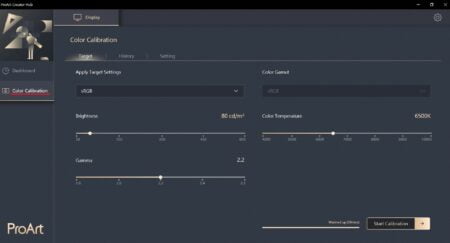
Initially, utilizing it can be quite intimidating. A Windows PC or a Mac, along with a Thunderbolt or USB-C cable, is required for connection. If HDMI is being used, an extra USB connection is necessary to facilitate data transfer. Once connected, the calibration process is relatively simple and even offers several pre-set options that utilize popular calibrators such as the Klein Colorimeter and the Datacolor SpyderX. These options are in addition to the built-in calibrator on the monitor, which securely attaches when in use.
Given the high cost and time-consuming nature of calibration using alternative tools, the ProArt option proves to be a favorable choice. Not only does it come with its own software, but purchasing the monitor also grants you a three-month subscription to Adobe Creative Cloud.

If you have a preference for the built-in tool or if you prefer to use your own, it is highly recommended to calibrate your screen to achieve the best possible results. This screen is truly stunning and has immense potential for accuracy. The OLED panel, with a resolution of 4K (3,840-by-2,160 pixels), boasts an impressive 10-bit color depth. To fully grasp the significance of this, take a moment to indulge your inner geek as we provide an explanation.
True 10-bit displays contain 10 bits for each pixel, resulting in 1,024 shades of RGB (red, green, and blue). When this number is cubed, it equates to 1.07 billion color shades that can be displayed on the screen. Bit depth, on the other hand, measures the accuracy in which these shades are shown. In the case of monitors, it indicates the bits per subpixel or bits per channel, representing the range of variations in red, green, and blue that can be exhibited.
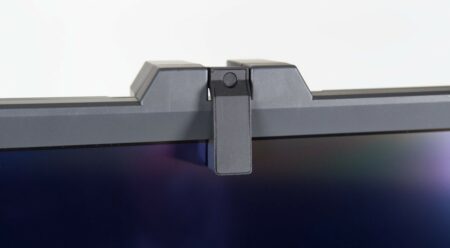
Now, what sets this apart from 8-bit? The calculations mentioned earlier still hold true, but the contrast is remarkable. An 8-bit display can only produce approximately 16.77 million colors using 256 RGB color tones. The expanded color spectrum of 10-bit monitors is crucial for tasks like video editing and design, and it undoubtedly distinguishes the Asus PA32DC OLED from its rivals.
The screen is compatible with various HDR modes, such as Dolby Vision, an HDR format that incorporates dynamic metadata to enhance the core HDR signal. This extra metadata offers guidance on how the display should showcase HDR content. Additionally, the monitor is equipped to handle HLG, an HDR standard that extends HDR support to broadcast TV signals, as well as HDR10, which guarantees compatibility with popular streaming services and an expanding selection of HDR-enabled games.
The monitor is capable of displaying multiple HDR modes, including Dolby Vision, an HDR format that includes dynamic metadata to enhance the core HDR signal. This additional metadata provides instructions on how the screen should present HDR content. Furthermore, the display supports HLG, an HDR standard that adds HDR compatibility to broadcast TV signals, and HDR10, which ensures compatibility with existing streaming video services and a growing number of HDR-enabled games.

However, the PA32DC does have certain limitations. Its display’s refresh rate is capped at 60Hz, preventing you from experiencing visuals beyond 60 frames per second (fps). While this may not be a significant concern for video editing, it becomes noteworthy if you intend to indulge in a fast-paced game like Overwatch 2. Additionally, if you are seeking a panel for game development purposes, this limitation should be taken into account.
Gamers will appreciate the ultra-fast response time of 0.1ms that we have tested. Although video editors may not prioritize response time as much as gamers, it still significantly affects how smoothly the display handles motion. Slow response times can negatively impact the quality of videos, particularly when there are numerous moving objects on the screen.
Evaluating the Asus PA32DC OLED: A Multitude of Vibrant Colors.
The Asus PA32DC OLED monitor is a high-performing device, but can we accurately measure its impressive features? To assess its true potential, we conducted several tests with the Calman monitor calibration software, a Murideo Six-G signal generator, and a Klein K-80 colorimeter using default settings. The results we obtained were not only fascinating but also remarkably outstanding.
Initially, we evaluate the monitor in its factory picture mode using an SDR signal. The Asus PA32DC OLED achieved a luminosity of 421 nits accompanied by a black level of 0. OLED technology is renowned for its ability to produce “true blacks,” where the pixel completely turns off, resulting in a complete absence of light and enhancing the picture contrast compared to IPS, VA, or TN panels. When testing HDR content, the brightness escalated to 486 nits, coming close to its maximum rating of 500 nits.

The Dell UltraSharp 27 4K PremierColor surpasses the 250-nit rating in brightness. It outshines the Asus ProArt PA34VC, which had 224 nits in SDR and 323 nits in HDR mode. Nevertheless, the Apple Pro Display XDR still outshines it with nearly 1,600 nits of brightness in HDR mode.
In our upcoming examination, we evaluate the color coverage of a monitor, and in this instance, we observed consistently outstanding outcomes. The Asus PA32DC OLED exhibited an impressive 99.8% coverage of the sRGB color gamut, 99.9% coverage of Adobe RGB, and 97.7% coverage of DCI-P3. These remarkable results surpass the performance of nearly all content creation monitors we have recently encountered, including the Apple Pro Display XDR.
The screen also offers an extensive range of contrast, appearing to have limitless possibilities on paper. It boasts a contrast ratio of 1,000,000:1, just like the Apple panel. A higher contrast ratio results in deeper blacks and brighter whites, enhancing the visual experience. This elevated contrast ratio is particularly beneficial for cinematic presentations, as it enhances high-resolution photography and video.

Our evaluation revealed a contrast ratio of 36,873:1, significantly lower than the advertised figure but still nearly 37 times greater than the typical 1,000:1 contrast ratio found in many premium consumer and gaming monitors. This demonstrates that extremely high or “infinite” contrast ratios, such as the ProArt’s specification, are often more about marketing terminology than practical performance metrics. In reality, contrast ratios in the thousands-to-one range are more common in everyday usage scenarios. The tested contrast ratio of 3,162:1 on the Asus ProArt PA34VC, for example, pales in comparison to our findings.
It is possible that a more crucial figure for specific professional tasks is the Delta E color accuracy measurement. Asus guarantees a Delta E of below 1 right out of the box, however, the chart indicates that an uncalibrated color accuracy assessment resulted in a Delta E of 1.9 in sRGB mode. Remember that the higher the number, the more common colors deviate from their truest forms; content creators aim for a value below 1, while the majority of mainstream monitor buyers prefer a value below 2.
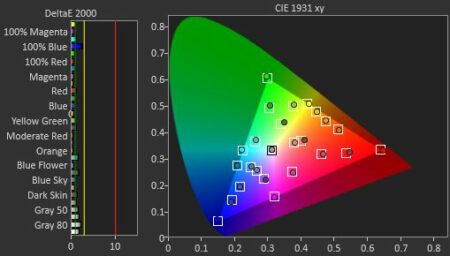
According to Asus, in order to achieve lower Delta E ratings, it is recommended to utilize the sRGB/Rec709 or DCI-P3 modes. The standard mode, as stated by the company, is designed to prioritize panel performance and may not necessarily yield a favorable Delta E rating.
After utilizing the Asus ProArt calibration tool, the Delta E showed significant improvement. Within the sRGB color space, we recorded a Delta E value of 1.5. The reason behind the initially high Delta E reading remains unclear, particularly since Asus advertises a lower rating with their factory settings. Our testing procedures involve no adjustments straight out of the packaging, suggesting that further calibration may be necessary to address this discrepancy. Nevertheless, given the price range of this product, we anticipate a low Delta E value without the need for extensive initial adjustments.
The impromptu testing yielded positive results, with our standard collection of images and videos appearing impressive on the PA32DC. Considering the outcomes from our various testing sessions and casual usage, the favorable outcome was to be expected.
Verdict: An Unparalleled Display Experience.
Overall, the Asus PA32DC OLED is a meticulously designed monitor tailored for skilled individuals in various fields. Whether it be filmmakers, colorists, or any other professional, this OLED display offers a comprehensive range of features that will surely meet the needs of both experts and enthusiasts. While some may still consider the Apple Pro Display XDR as the ultimate choice for content creation, the Asus PA32DC OLED presents a compelling alternative at a significantly lower price point (especially when factoring in the costly stand of the XDR). Additionally, this monitor is versatile enough to deliver exceptional performance even outside of the macOS ecosystem, unlike the XDR which is primarily optimized for Mac hardware.
The Asus PA32DC OLED falls short of receiving our Editors’ Choice award due to its high initial Delta E test result. However, if you are willing to invest some time in color calibration, there are very few aspects to criticize about this monitor. While it may not be the ideal choice for novice content creators, if you seek top-notch quality, the Asus PA32DC OLED is definitely worth getting enthusiastic about.

